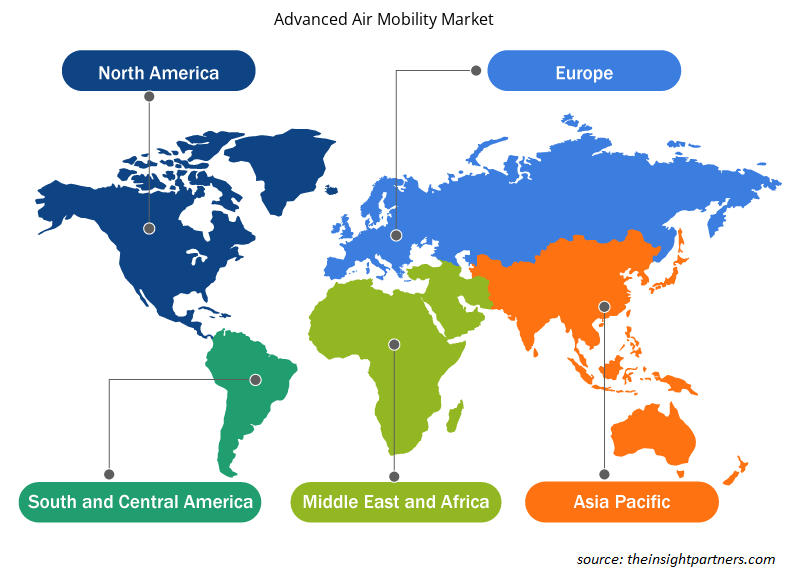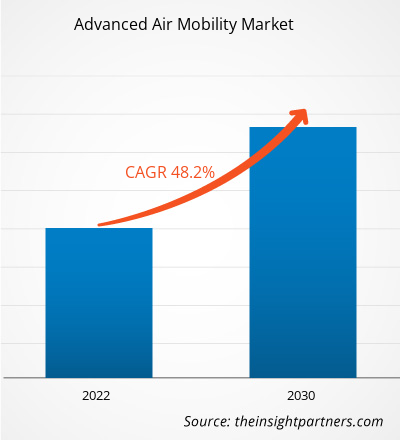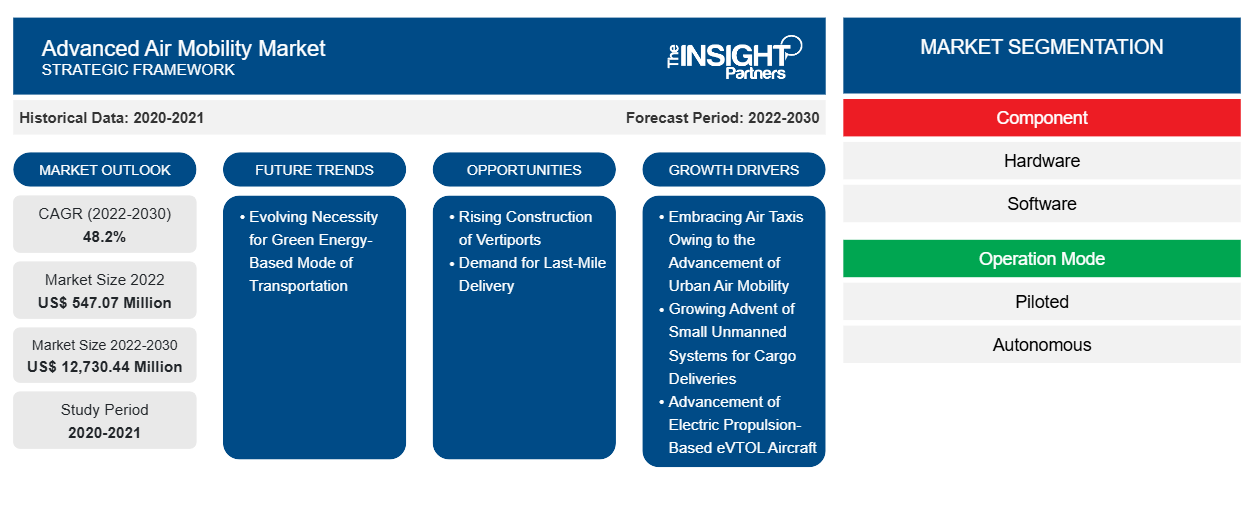Der Markt für fortschrittliche Luftmobilität wurde im Jahr 2022 auf 547,07 Millionen US-Dollar geschätzt und soll bis 2030 12.730,44 Millionen US-Dollar erreichen; von 2022 bis 2030 wird ein durchschnittliches jährliches Wachstum von 48,2 % erwartet. Der wachsende Bedarf an auf grüner Energie basierenden Transportmitteln dürfte ein wichtiger Trend auf dem Markt für fortschrittliche Luftmobilität bleiben.
Marktanalyse für erweiterte Luftmobilität
Zu den wichtigsten Akteuren auf dem AAM-Markt zählen Rohstoff- und Komponentenlieferanten, Batteriehersteller und Endverbraucher. Da der Markt für eVTOL-Flugzeuge noch nicht kommerzialisiert ist und sich noch in der Test- und Entwicklungsphase befindet, konzentrieren sich die Batterie- und anderen Komponentenhersteller für AAM-Flugzeugunternehmen auch auf die Entwicklung neuer und innovativer Batterietechnologien, um einen Vorreitervorteil auf dem Markt zu haben, da viele Unternehmen versuchen, in die AAM-Branche einzusteigen.
Marktübersicht für erweiterte Luftmobilität
Die urbane Luftmobilität ist ein völlig neuer Aspekt des Luftverkehrs, der den Akteuren in der Luftfahrt neue Möglichkeiten bietet und die Entwicklung von eVTOL-Flugzeugen unterstützt. Viele Unternehmen entwickeln eVTOL-Flugzeuge und werden von Investoren und Luftfahrtbehörden unterstützt. So gründete die britische Zivilluftfahrtbehörde (CAA) im Oktober 2021 während der HeliTech Expo in London ein neues, sicherheitsorientiertes internationales Konsortium aus Entwicklern und Betreibern von eVTOL-Flugzeugen. Dieses neue Konsortium hat die Aufgabe, die Sicherheitsherausforderungen zu berücksichtigen, die gelöst werden müssen, damit eVTOL-Flugzeuge und Drohnentaxis kommerziell auf dem Markt erhältlich sind. Im Jahr 2018 gründete die Internationale Zivilluftfahrt-Organisation (ICAO) mit Hauptsitz in Montreal, Kanada, die gemeinnützige Organisation Ambular. Das Ziel von Ambular ist die Entwicklung eines Open-Source-eVTOL- Flugzeugs für den Rettungsdienst (EMS). eVTOL-Flugzeugtechnologien werden derzeit entwickelt und erprobt. Herausforderungen wie Bodeninfrastruktur, wirtschaftliche Kosten oder Energiedichte der Batterien müssen jedoch von den Akteuren auf dem Markt für fortschrittliche Luftmobilität bewältigt werden
Passen Sie diesen Bericht Ihren Anforderungen an
Sie erhalten kostenlos individuelle Anpassungen an jedem Bericht, einschließlich Teilen dieses Berichts oder einer Analyse auf Länderebene, eines Excel-Datenpakets sowie tolle Angebote und Rabatte für Start-ups und Universitäten.
-
Holen Sie sich die wichtigsten Markttrends aus diesem Bericht.Dieses KOSTENLOSE Beispiel umfasst eine Datenanalyse von Markttrends bis hin zu Schätzungen und Prognosen.
Treiber und Chancen auf dem Markt für fortschrittliche Luftmobilität
Das Aufkommen kleiner unbemannter Systeme für Frachtlieferungen
Der technologische Fortschritt im Bereich der Luftmobilität treibt die Entwicklung kleiner, unbemannter Drohnen für Frachtlieferungen voran. Die steigende Nachfrage nach schneller Lieferung von Sendungen am selben Tag und die Notwendigkeit, wichtige Güter an unerreichbare und abgelegene Orte zu liefern, steigern die Nachfrage nach kleinen, unbemannten Drohnen. Die unbemannten Luftdrohnen können zur Lieferung einer Reihe von Frachten eingesetzt werden, darunter in erster Linie Ersatzteile, Handelswaren, medizinisches Material, Lebensmittel und Impfstoffe. Darüber hinaus können unbemannte Luftdrohnen auch zur Zustellung von Postsendungen auf abgelegenen Baustellen oder Offshore-Standorten eingesetzt werden. Die zunehmende Verbreitung unbemannter Drohnen in den Logistik- und Frachtdiensten. So arbeitete Skye Air Mobility im Jahr 2022 mit Dunzo zusammen, um drohnengesteuerte Lebensmittellieferdienste in Karnataka zu testen und zu erproben. Im Jahr 2022 arbeitete Swiggy mit Garuda Aerospace zusammen, um Drohnen zur Lieferung von Lebensmitteln in Bengaluru und Delhi NCR zu testen. Auch Frachtdrohnen gewinnen an Bedeutung, da sie eine praktikable Option zur Verringerung des CO2-Fußabdrucks und der Umweltverschmutzung darstellen. Der wachsende Fokus auf die Reduzierung des CO2-Fußabdrucks im Logistik- und Luftfahrtsektor fördert die Entwicklung von Frachtdrohnen weltweit. So schloss Leonardo SpA im Jahr 2021 den ersten Test seiner Drohnenlieferung „Sumeri Moderni“ in Turin ab. Im Jahr 2022 arbeitete FedEx Corp. mit Elroy Air zusammen, um bis 2023 ihr autonomes eVTOL-Luftfrachtsystem für Logistikoperationen auf mittleren Meilen zu testen.Dunzo to test and trial drone-driven food delivery services in Karnataka. In 2022, Swiggy collaborated with Garuda Aerospace to trial drones to deliver groceries in Bengaluru and Delhi NCR. Cargo drones are also gaining momentum as it is a viable option to mitigate the carbon footprint and lower the level of environmental pollution. Growing focus on lowering the carbon footprint in the logistics and aviation sector is boosting the development of cargo drones globally. For instance, in 2021, Leonardo S.p.A. completed the first trial of its "Sumeri Moderni" drone-based delivery in Turin. In 2022, FedEx Corp. collaborated with Elroy Air to trial their autonomous eVTOL air cargo system for middle-mile logistics operations by 2023.
Zunehmender Bau von Vertiports – eine Chance auf dem Markt für fortschrittliche LuftmobilitätVertiports – An Opportunity in the Advanced Air Mobility Market
Vertiports sind Zentren für Fahrzeuge mit vertikalem Start und Landung wie eVTOL-Fahrzeuge, Drohnen und Lufttaxis. Die steigende Nachfrage nach kompetentem Stadtverkehr und Entwicklungen in der eVTOL-Technologie sowie der Mangel an verfügbarem Land zum Bau konventioneller Vertiports treiben den Bedarf an fortschrittlichen Vertiports voran, die in gewisser Weise einen der Meilensteine für den Markt für fortschrittliche Luftmobilität weltweit darstellen. Im Jahr 2022 kündigte VPorts an, ein Netzwerk von Vertiports in Quebec aufzubauen und Korridore zwischen Quebec und den USA speziell für eVTOL-Flugzeuge zu bilden. Das Unternehmen strebte außerdem an, im Jahr 2023 mit eVTOL-Testflügen zu beginnen. Im Jahr 2023 arbeiteten Siemens und Skyway zusammen, um die digitale und elektrische Infrastruktur sicherzustellen, die für den Betrieb von Vertiports erforderlich ist. Im Jahr 2023 arbeitete Ferrovial Airports mit Eva Air Mobility zusammen, um Vertiports für eVTOL-Flugzeuge zu entwickeln. Die wachsende Nachfrage nach nachhaltigen und kohlenstoffarmen Ansätzen im Luftfahrt- und Logistiksektor steigert die Nachfrage nach fortschrittlichen Luftmobilitätsdiensten. are centers for vertical takeoff and landing vehicles such as eVTOL vehicles, drones, and air taxis. The increasing demand for competent urban transportation and developments in eVTOL technology and the shortage of available land to build conventional vertiports fuel the need for advanced vertiports, which, in a way, is one of the landmarks for the advanced air mobility market globally. In 2022, VPorts declared to establish a network of vertiports in Quebec and to form corridors between Quebec and the US specifically for eVTOL aircraft. The company also aimed at starting eVTOL test flights in 2023. In 2023, Siemens and Skyway collaborated to ensure the digital and electrical infrastructure required to facilitate vertiport operations. In 2023, Ferrovial Airports collaborated with Eva Air Mobility to develop vertiports for eVTOL aircraft. The growing demand for sustainable and low-carbon emission approaches in the aviation and logistics sector boost the demand for advanced air mobility services.
Segmentierungsanalyse des Marktberichts zur erweiterten Luftmobilität
Wichtige Segmente, die zur Ableitung der Marktanalyse für fortschrittliche Luftmobilität beigetragen haben, sind Komponente, Betriebsmodus, Antriebsart und Endverwendung.
- Basierend auf den Komponenten ist der Markt für fortschrittliche Luftmobilität in Hardware und Software unterteilt. Das Hardwaresegment hatte im Jahr 2022 einen größeren Marktanteil.
- Basierend auf der Betriebsart ist der Markt in pilotierte und autonome Fahrzeuge segmentiert. Das pilotierte Segment hatte im Jahr 2022 einen größeren Marktanteil.
- In Bezug auf die Antriebsart ist der Markt in vollelektrisch und hybrid unterteilt. Das vollelektrische Segment dominierte den Markt im Jahr 2022.
- Basierend auf der Endnutzung ist der Markt in Passagier- und Frachtverkehr segmentiert. Das Passagiersegment hatte im Jahr 2022 einen größeren Marktanteil.
Marktanteilsanalyse für erweiterte Luftmobilität nach geografischer Lage
Der geografische Umfang des Marktberichts zur erweiterten Luftmobilität ist hauptsächlich in fünf Regionen unterteilt: Nordamerika, Asien-Pazifik, Europa, Naher Osten und Afrika sowie Südamerika.
Im Jahr 2023 hatte Nordamerika einen großen Anteil am globalen Markt für fortschrittliche Luftmobilität, gefolgt von Europa und dem asiatisch-pazifischen Raum. Die geografische Diversifizierung über verschiedene nordamerikanische Länder und die Präsenz großer Flugzeughersteller wie Bell Textron Inc., Joby Aviation und Kitty Hawk sind die Hauptfaktoren, die den Verkauf von eVTOL-Flugzeugen in Nordamerika vorantreiben. Die US Air Force hat ihre Initiative Agility Prime offiziell eingeführt, um das Wachstum der eVTOL-Technologie zu beschleunigen. Der wachsende Wettbewerb auf dem Markt konzentriert sich hauptsächlich darauf, die Flugzeugzertifizierung der US-Luftfahrtbehörde Federal Aviation Administration zu erhalten und den kommerziellen Betrieb aufzunehmen. Im April 2022 konnte Jaunt Air Mobility zwei neue private Investoren gewinnen, um seine Pläne zur Markteinführung eines viersitzigen eVTOL-Flugzeugs im Jahr 2026 zu finanzieren. Solche Entwicklungen bei eVTOL-Flugzeugen treiben also das Marktwachstum der fortschrittlichen Luftmobilität in Nordamerika voran.
Regionale Einblicke in den Markt für erweiterte Luftmobilität
Die regionalen Trends und Faktoren, die den Markt für fortschrittliche Luftmobilität im Prognosezeitraum beeinflussen, wurden von den Analysten von Insight Partners ausführlich erläutert. In diesem Abschnitt werden auch Marktsegmente und Geografien für fortschrittliche Luftmobilität in Nordamerika, Europa, im asiatisch-pazifischen Raum, im Nahen Osten und Afrika sowie in Süd- und Mittelamerika erörtert.

- Erhalten Sie regionalspezifische Daten zum Markt für fortschrittliche Luftmobilität
Umfang des Marktberichts zur erweiterten Luftmobilität
| Berichtsattribut | Details |
|---|---|
| Marktgröße im Jahr 2022 | 547,07 Millionen US-Dollar |
| Marktgröße bis 2030 | 12.730,44 Millionen US-Dollar |
| Globale CAGR (2022-2030) | 48,2 % |
| Historische Daten | 2020-2021 |
| Prognosezeitraum | 2022–2030 |
| Abgedeckte Segmente |
Nach Komponente
|
| Abgedeckte Regionen und Länder |
Nordamerika
|
| Marktführer und wichtige Unternehmensprofile |
|
Marktteilnehmerdichte: Der Einfluss auf die Geschäftsdynamik
Der Markt für fortschrittliche Luftmobilität wächst rasant. Dies wird durch die steigende Nachfrage der Endnutzer aufgrund von Faktoren wie sich entwickelnden Verbraucherpräferenzen, technologischen Fortschritten und einem größeren Bewusstsein für die Vorteile des Produkts vorangetrieben. Mit der steigenden Nachfrage erweitern Unternehmen ihr Angebot, entwickeln Innovationen, um die Bedürfnisse der Verbraucher zu erfüllen, und nutzen neue Trends, was das Marktwachstum weiter ankurbelt.
Die Marktteilnehmerdichte bezieht sich auf die Verteilung von Firmen oder Unternehmen, die in einem bestimmten Markt oder einer bestimmten Branche tätig sind. Sie gibt an, wie viele Wettbewerber (Marktteilnehmer) in einem bestimmten Marktraum im Verhältnis zu seiner Größe oder seinem gesamten Marktwert präsent sind.
Die wichtigsten auf dem Markt für erweiterte Luftmobilität tätigen Unternehmen sind:
- Airbus SE
- EHang Holdings Ltd
- Bell Textron Inc
- Die Boeing Company
- Embraer SA
- Elbit Systems GmbH
Haftungsausschluss : Die oben aufgeführten Unternehmen sind nicht in einer bestimmten Reihenfolge aufgeführt.

- Überblick über die wichtigsten Akteure auf dem Markt für erweiterte Luftmobilität
Nachrichten und aktuelle Entwicklungen zum Markt für fortschrittliche Luftmobilität
Der Markt für fortschrittliche Luftmobilität wird durch die Erfassung qualitativer und quantitativer Daten nach Primär- und Sekundärforschung bewertet, die wichtige Unternehmensveröffentlichungen, Verbandsdaten und Datenbanken umfasst. Im Folgenden finden Sie eine Liste der Entwicklungen auf dem Markt für Innovationen, Geschäftserweiterungen und Strategien:
- Im Jahr 2023 ging die Thales Group eine Partnerschaft mit Eve Mobility für die Entwicklung von eVTOL ein. Thales kündigte an, die Entwicklung seines elektrischen Senkrechtstarters und -landeflugzeugs in Brasilien zu unterstützen. Die strategische Partnerschaft umfasst eine Reihe gemeinsamer Studien über einen Zeitraum von zwölf Monaten, die im Januar 2022 begannen und sich mit der technischen, wirtschaftlichen und anpassungsfähigen Machbarkeit eines zu 100 % elektrisch betriebenen Flugzeugs befassen. (Quelle: Thales Group, Pressemitteilung)
- Im Jahr 2023 erhielt Joby ein Sonderzeugnis für die Lufttüchtigkeit des ersten Flugzeugs, das in seiner Pilotproduktionslinie in Marina, Kalifornien, gebaut wurde, sodass die Flugerprobung beginnen konnte. Das Flugzeug wird voraussichtlich das erste eVTOL-Flugzeug sein, das an einen Kunden ausgeliefert wird. Produktionslinie und Flugzeug wurden in enger Zusammenarbeit mit dem strategischen Partner und Investor Toyota gebaut. Der Gouverneur von Kalifornien, Gavin Newsom, besuchte Joby aus diesem Anlass. (Quelle: Joby Aviation, Newsletter)
Marktbericht zur erweiterten Luftmobilität – Abdeckung und Ergebnisse
Der Bericht „Advanced Air Mobility Market Size and Forecast (2020–2030)“ bietet eine detaillierte Analyse des Marktes, die die folgenden Bereiche abdeckt:
- Größe und Prognose des Marktes für erweiterte Luftmobilität auf globaler, regionaler und Länderebene für alle wichtigen Marktsegmente, die im Rahmen des Berichts abgedeckt sind
- Marktdynamik wie Treiber, Beschränkungen und wichtige Chancen
- Markttrends für fortschrittliche Luftmobilität
- Detaillierte Porters Fünf Kräfte
- Marktanalyse für erweiterte Luftmobilität mit wichtigen Markttrends, globalen und regionalen Rahmenbedingungen, wichtigen Akteuren, Vorschriften und jüngsten Marktentwicklungen
- Advanced Air Mobility (AAM) Branchenlandschaft und Wettbewerbsanalyse, einschließlich Marktkonzentration, Heatmap-Analyse, prominenten Akteuren und jüngsten Entwicklungen
- Detaillierte Firmenprofile
- Historische Analyse (2 Jahre), Basisjahr, Prognose (7 Jahre) mit CAGR
- PEST- und SWOT-Analyse
- Marktgröße Wert/Volumen – Global, Regional, Land
- Branchen- und Wettbewerbslandschaft
- Excel-Datensatz
Aktuelle Berichte
Erfahrungsberichte
Grund zum Kauf
- Fundierte Entscheidungsfindung
- Marktdynamik verstehen
- Wettbewerbsanalyse
- Kundeneinblicke
- Marktprognosen
- Risikominimierung
- Strategische Planung
- Investitionsbegründung
- Identifizierung neuer Märkte
- Verbesserung von Marketingstrategien
- Steigerung der Betriebseffizienz
- Anpassung an regulatorische Trends























 Kostenlose Probe anfordern für - Markt für fortschrittliche Luftmobilität
Kostenlose Probe anfordern für - Markt für fortschrittliche Luftmobilität